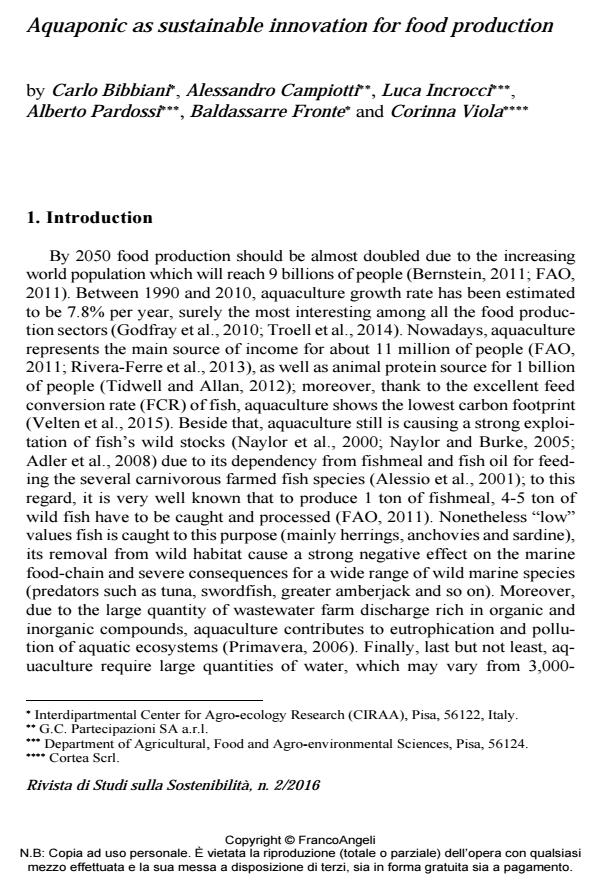Aquaponic as sustainable innovation for food production
Journal title RIVISTA DI STUDI SULLA SOSTENIBILITA'
Author/s Carlo Bibbiani, Alessandro Campiotti, Luca Incrocci, Alberto Pardossi, Baldassarre Fronte, Corinna Viola
Publishing Year 2017 Issue 2016/2
Language English Pages 10 P. 249-258 File size 148 KB
DOI 10.3280/RISS2016-002022
DOI is like a bar code for intellectual property: to have more infomation
click here
Below, you can see the article first page
If you want to buy this article in PDF format, you can do it, following the instructions to buy download credits

FrancoAngeli is member of Publishers International Linking Association, Inc (PILA), a not-for-profit association which run the CrossRef service enabling links to and from online scholarly content.
To better understand aquaponic, it is important to describe the socio-demographic context and the role of agriculture in a future perspective. Due to the increasing world population, by 2050 food production should be increased of not less than 70%. Nowadays the agriculture sector is playing a key role in ensuring food security and in the upcoming context it should also face one of the greatest dilemmas of the modern age, which consist in producing more food using less resources and minimizing the environmental impacts. To cope with this challenge, the aquaculture technology seems to be one of the most suitable production systems able to face this dilemma. In this paper, the technical and technological aspects of the Integrated Aquaponic System (IAS) are described. The integration of an aquaponic system with algae, worms and insects production it is also suggested for improving sustainability.
Keywords: Aquaculture, aquaponic, food security, agriculture, sustainability
- Preliminary study on eel breeding and vegetables production in an aquaponic system B. Fronte, L. Incrocci, G. Galliano, G. Carmassi, A. Pardossi, C. Bibbiani, in Acta Horticulturae /2021 pp.415
DOI: 10.17660/ActaHortic.2021.1305.54 - Sustainability of the rice-crayfish co-culture aquaculture model: microbiome profiles based on multi-kingdom analyses Xue Zhu, Lei Ji, Mingyue Cheng, Huimin Wei, Zhi Wang, Kang Ning, in Environmental Microbiome 27/2022
DOI: 10.1186/s40793-022-00422-4
Carlo Bibbiani, Alessandro Campiotti, Luca Incrocci, Alberto Pardossi, Baldassarre Fronte, Corinna Viola, Aquaponic as sustainable innovation for food production in "RIVISTA DI STUDI SULLA SOSTENIBILITA'" 2/2016, pp 249-258, DOI: 10.3280/RISS2016-002022